Driven: Ferrari's F1 'flop' that could have been a race winner
Ferrari's 555 racer was christened 'The Shark' but in the 1950s it was more minnow that man-eater. Now, forty years on, Willie Green takes on Maserati's fabled 250F and finds the Super Squalo fighting back
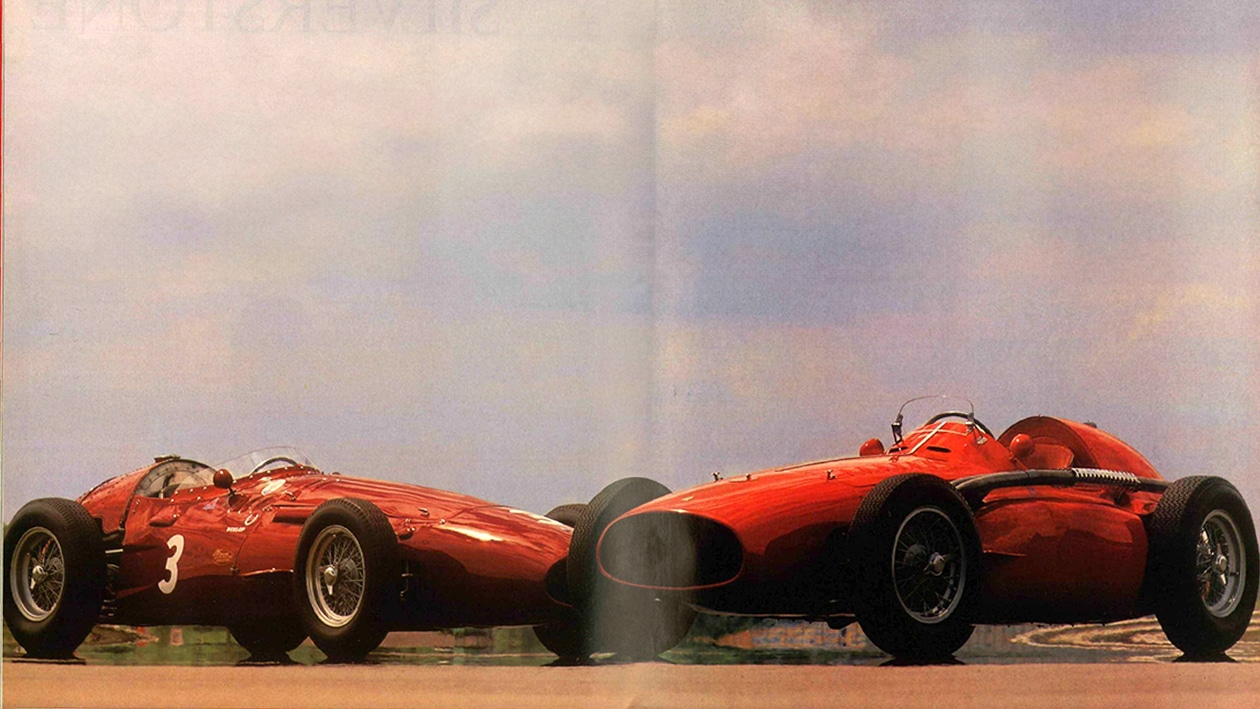
Andew Yeadon
Italy 1953.
Ferrari designer Aurelio Lampredi wheels out Maranello’s answer to Mercedes’ W196. Sleek and low, with curvaceous side-tanks, the 553 Squalo looks like a mean rival to the silver cars. Within 18 months it will be forgotten.
In one of his rare interviews with the press, Enzo Ferrari was once asked what he considered to be his most successful car. In typical fashion he replied: “I can’t lay my finger on the most successful car in an absolute sense, because as soon as the latest product lets out its first infant sounds, I always feel the dissatisfaction of the engineer. It has to be that way. The most successful Ferrari is the one which has still to be built.”
At the end of 1953, Ferrari must have felt that dissatisfaction more strongly than ever before, for two years of world championship domination were about to be swapped for a sustained period in the wilderness. Mercedes-Benz was due to unleash its unstoppable W196, and the Scuderia’s riposte was a mixed bag of racers none capable of holding off the German challenge.
For that difficult ’54 season, Lampredi had set to work on an unusual new car that he hoped would bring the team the kind of success it had enjoyed with Alberto Ascari during Grand Prix racing’s Formula Two period. With the 2-litre, four-cylinder Type 500, the brilliant Italian had dominated two world championships, and for 1954 the advent of the new 2.5-litre formula Lampredi *hoped to keep that run going with the innovative looking Squalo the ‘Shark’.
In its early F2 guise, the car developed 190bhp from its 2-litre four-cylinder engine. With the extra 500cc allowed under the ’54 rules, that figure rose to over 250bhp the first unblown Ferrari engine to develop in excess of 100bhp per litre. The new Squalo raced in conjunction with another Maranello chassis, the Type 625 itself a direct evolution of Ascari’s 500 yet despite the obvious strengths of Lampredi’s engine, the car enjoyed only limited success. Never as forgiving a racer as the 625 and certainly no match for its rivals, the drivers pointed accusingly at the short wheelbase and low slung, side-mounted hid tanks, which gave the car its unusual head-on appearance, and complained of instability and handling problems.
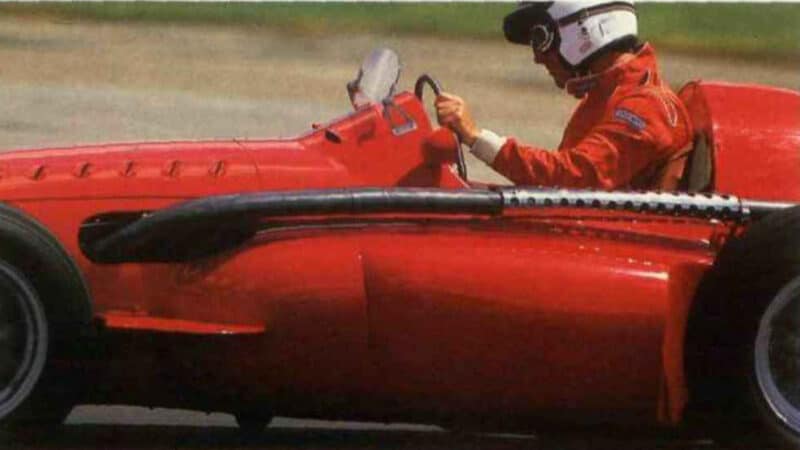
The 555 Super Squalo was not the evil handling beast that Green expected
Andrew Yeadon
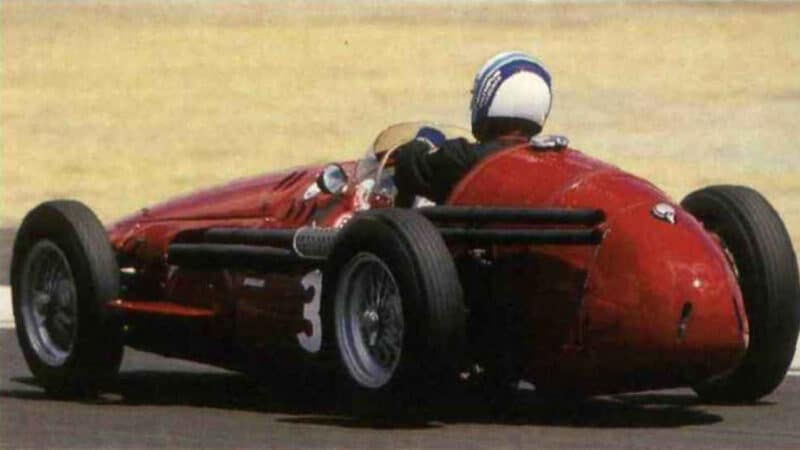
Beautifully proportioned Maserati 250F took Behra to four GP podiums
Andrew Yeadon
Mike Hawthorn drove the 553 Squalo to a lone victory at the end-of-season Spanish Grand Prix, but for 1955 Ferrari modified its unresponsive chassis to become the 555 Super Squalo, with a yet lower profile, increased compression ratio and 270bhp. Like its predecessor, it was no match for Juan Manuel Fangio and the W196.
Although the Super Squalo raced through the ’55 championship, its death knell had already been sounded. For in May of that year Ascari was killed while testing a Ferrari sportscar at Monza. His Lancia team opted to withdraw from the Grand Prix scene and Gianni Lancia gave six Type D50 cars to his rival Ferrari who, with the newly acquired J.M Fangio on board, went on to win the 1956 world championship. The Super Squalo was quickly consigned to the scrap heap.
He shoehorned a Chevrolet V8 inside, bolted a Morris Minor body on and took it saloon racing
Maserati’s answer to the Ferrari/Mercedes battle of the period was the six-cylinder 250F. Like the Ferrari 555, the Maserati was an evolution of its F2 antecedent, the A6SSG. But unlike the 555, the six-cylinder 250F would remain at the forefront of the 2.5-litre formula for several years. In the early 1950s Maserati had stuck rigidly to a solid rear axle on its Grand Prix racers, but with the 250F, the marque relented and with a De Dion axle, single-unit rear-mounted gearbox and differential, the car was a joy to drive. A winner on its debut in Fangio’s hands in Argentina, the 250F won seven further races before bowing out in 1958. Thirty-four 250Fs were built between 1954 and 1958, and Fangio took his fifth world title in one in 1957.
By which point the Super Squalo was just a distant memory in the minds of Maranello. The model did finally have its moment of glory, though. Two of the cars were fitted with 3.5-litre 860 Monza engines and shipped round the world to Australia, where they were raced with great success by Peter Whitehead and Reg Parnell.
One of those cars, chassis 555/1 (renumbered FL 9001, for Formula Libre) then went to New Zealand, where during the 1960s stock-car driver Garth Souness shoehorned a Chevrolet V8 inside, unbelievably bolted a Morris Minor body onto the frame, and took it saloon racing. In the early Seventies the original 2.5-litre power unit was discovered, and both engine and car came to rest in the Hayashi collection, eventually making their way to the workshops of Tony Merrick where Super Squalo 555/1 now rests, perfectly restored.
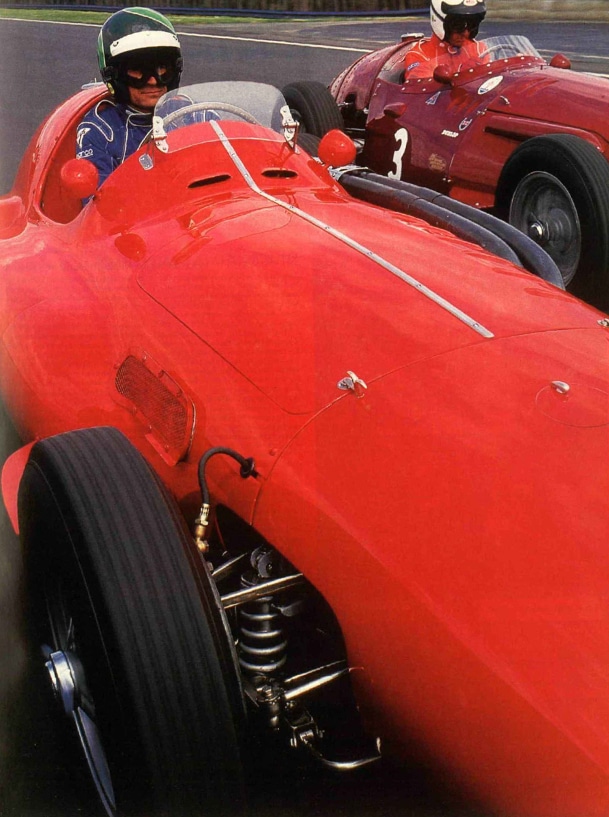
England, 1997
Chassis 555/1 stands ready to run on Siverstone’s South Circuit. Alongside it Jean Behra’s Maserati 250F. For the first time since the mid-1950s, the Super Squalo is about to undergo direct comparison against one of its most illustrious contemporaries.
Super Squalo 555/1 raced in five Grands Prix, its best result coming at Spa in the hands of Paul Frere, who finished fourth, although Hawthorn, Giuseppe Farina and Piero Taruffi also raced it. The 250F on hand for comparison is an ex-works machine that Behra took to four podiums finishes in the 1956 season Spa, Reims, Silverstone and the Nurburgring. Both are immaculate. Both are set to go head-to-head to see just what makes the archetypal 1950s monoposto racer. The results, as you will see, prove that you should not believe everything that you read in the history books.
A visual comparison gives early clues to just what one might expect from the two chassis. Parked side-by-side there are many similarities front engine, rear transaxle, drum brakes, seat on top of the propshaft. But the 250F is more graceful to look at; a clean sweep of the designer’s pen takes the eye from nose to tail. The Squalo is shorter and fatter; its ‘sidepod’ fuel tanks giving the impression of a wider track. The figures are, in fact, very similar.
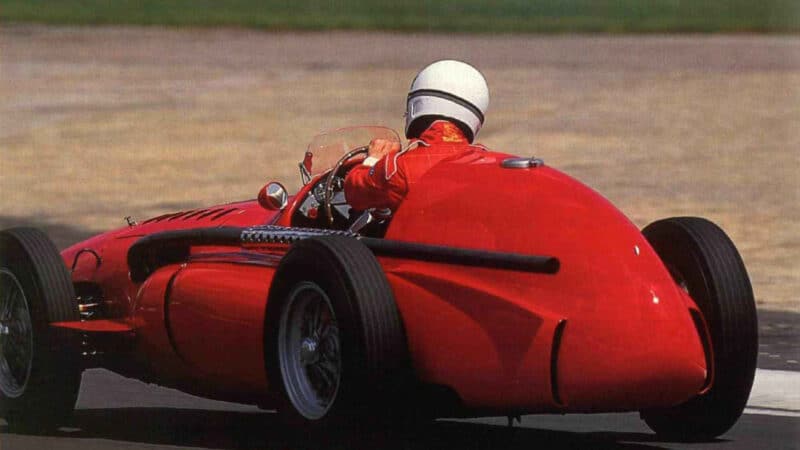
Side fuel tanks with gill-slits plus short wheelbase led to the ‘Shark’ nickname. It also gives the Super Squalo a tendency to roll oversteer according to Green
Andrew Yeadon
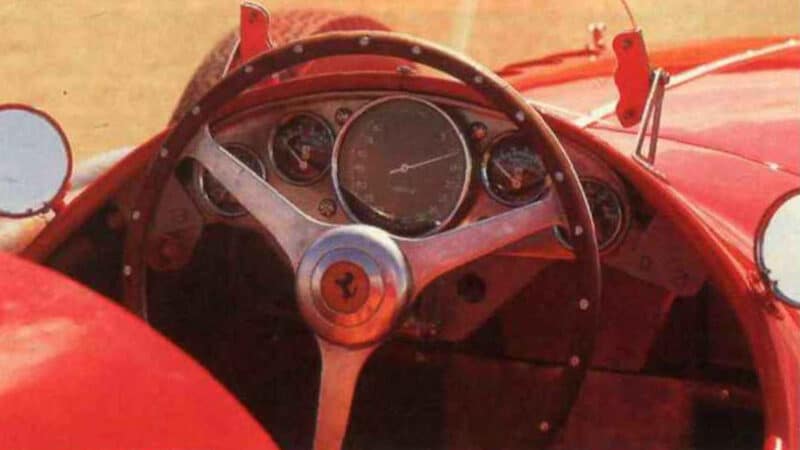
Enormous Veglia rev counter dominates the beautifully contoured cockpit
Andrew Yeadon
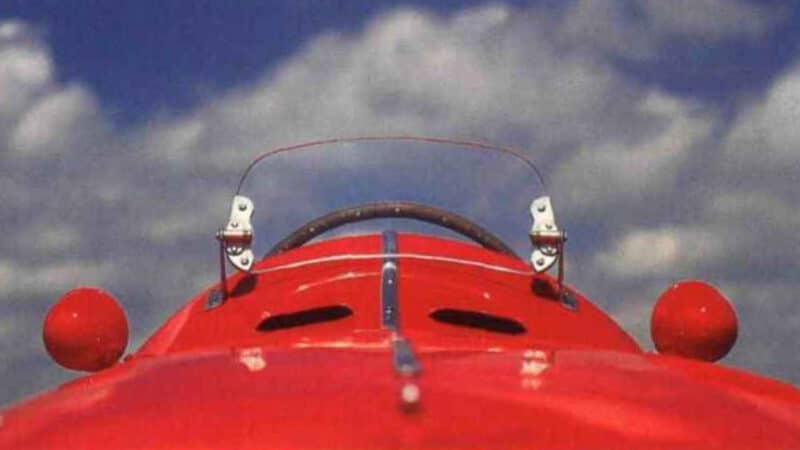
Flared cockpit rim and mini screen gives aggressive edge to Squalo’s look
Andrew Yeadon
A closer inspection of the two cockpits reveals further differences. The Squalo’s nose rises sharply to an aeroscreen mounted on two swivelling hinges. The whole appearance is more aggressive, more purposeful; the flared cockpit concentrating the eye on the driver at work.
The Ferrari comes out ahead on points when you take a look inside the cockpit as well. You slide down into the beautiful, tan corduroy seat, your feet at least six inches further apart than in the 250F, yet still very comfortable. Ahead of you the dashboard is the work of an ergonomic master, all around the chassis reveals the work of a master craftsman. The attention to detail on every rivet, every fold of aluminium is outstanding. In front of you a huge Veglia rev counter fills your vision, as your hands grasp the wide, wooden wheel with the faded yellow Prancing Horse strident in the centre.F1
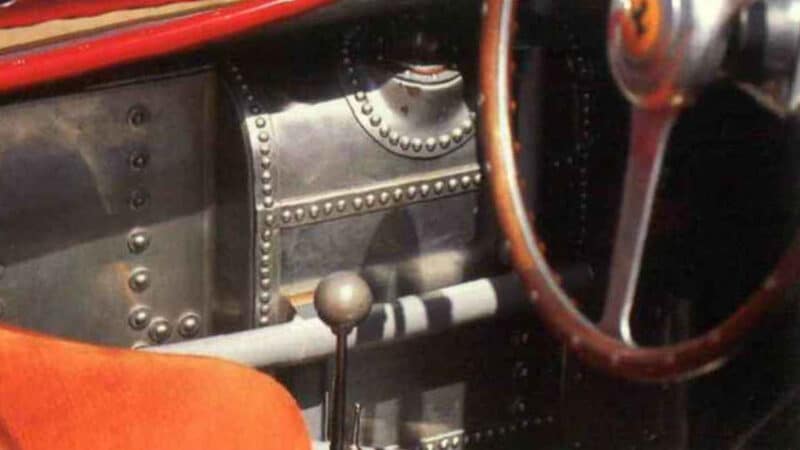
Incredible rivet work catches the eye as well as left-mounted five-speed ‘box
Andrew Yeadon
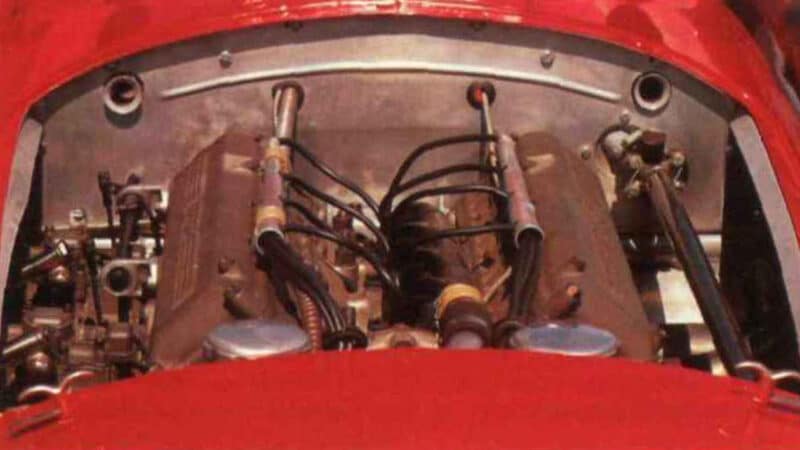
Four-cylinder block no aural masterpiece but still gave over 100bhp per litre
Andrew Yeadon
The Maserati’s cockpit and dash are less pure, more functional perhaps. Far fewer dials grace the panel ahead of you; just a rev counter winding its way to 10,000 revolutions per minute (2,000 more than the Squalo) hints at the difference in engine configuration. Both cars carry a five-speed gearbox, the Squalo’s shift mounted low down to the left, the Maserati’s more conventionally on the right.
Still set up to run methanol fuel, it took a little gentle persuasion to kick the Ferrari into life. Large four-cylinder racing engines always seem rough at low revs, but with a bit of throttle the exhaust note cleared to a crisp, even tone.
Heading out onto the South Circuit and down the Hangar Straight, the Ferrari pulled cleanly and powerfully through the range. There didn’t, however, seem to be much above an indicated 6,000rpm perhaps hinting at the rev counter running a tad slow. In reality the 2.5-litre block was probably pulling cleanly round to about 7,200. Nevertheless, the power was definitely there and allied to a smooth gear change even if the lever seemed quite a long way away progress was satisfyingly rapid.
The original 555 Super Squalo was fitted with a four-speed gearbox, but towards the end of its life the legendary designer Vittorio Jano added an extra ratio, something that transformed the car and allied to improved handling helped Eugenio Castellotti finish a brilliant third behind the two Mercedes of Fangio and Taruffi at the Italian GP. The Italian may have come in over 40 seconds behind the two German machines, but when you consider that fourth-placed jean Behra’s 250F was three minutes further adrift, the qualities of the much-maligned Super Squalo are put into some perspective.
At the end of the Hangar Straight the drum brakes seem adequate as you slow the scarlet machine for the right-hander at Stowe, but modern circuits can create a major problem for historic cars. Repeated chicanes and slow corners don’t give brakes time to cool and as a result I never tested them to their limit.
It is as you turn quickly into Stowe corner that the first obvious difference between the two cars becomes apparent. The Ferrari seems to go into roll oversteer on approach to a corner; a complete contrast to the Maserati, which slides the rear end dependent on the amount of throttle applied.
Do not , however, be fooled into thinking that the Squalo is a bad handling car, it is still very quick round corners, and remains easy to control with a combination of steering and throttle inputs. Maserati 250Fs have been developed over the last 30 years in historic racing and the experts know them inside out. This Ferrari has had little serious testing and is far far better than I had anticipated. With just minor development it is easily capable of running in the midfield with the mid ’50s GP cars raced today.
I have driven about 15 Maserati 250Fs in the past and this one, chassis 2521 was one I hadn’t sat in; so it was a definite bonus. It was great to drive and you quickly remember how much fun they are. You don’t really sit in a Maserati when you are out on track. It’s almost as if you are wearing it.
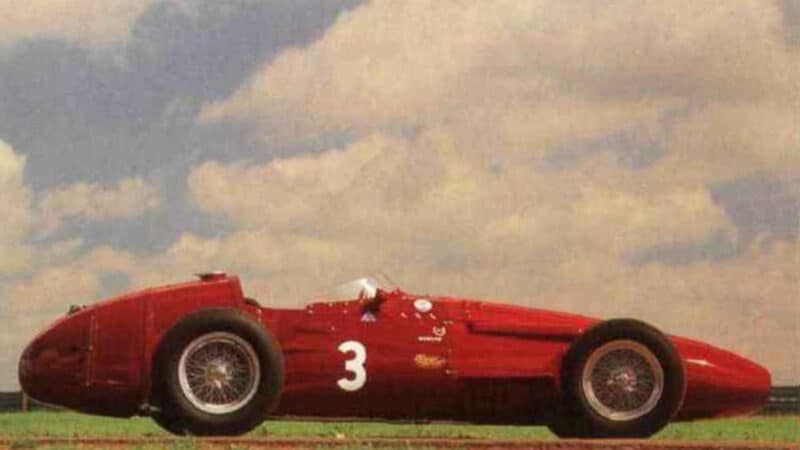
Maserati’s 250F is perhaps the archetypal monoposto racer of the 1950s
Andrew Yeadon
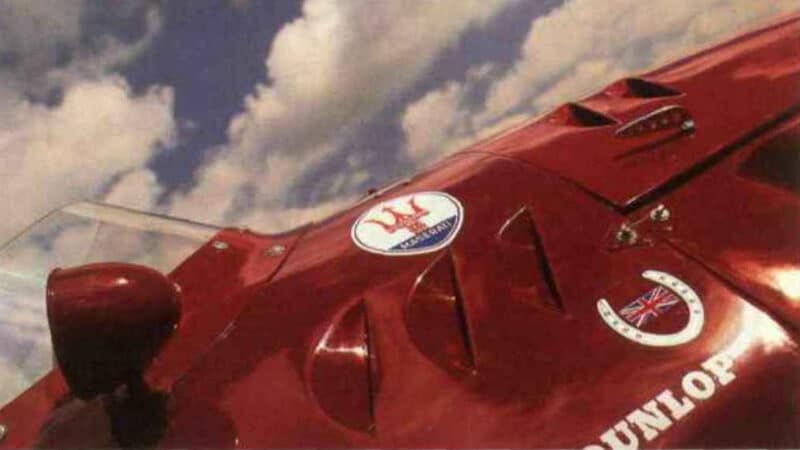
Air deflector less crafted than Super Squalo version but effective nevertheless
Andrew Yeadon
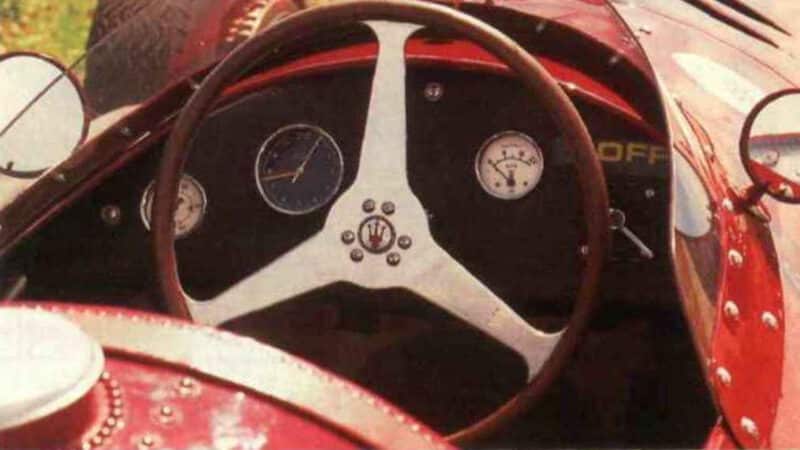
Spartan cockpit is complete contrast to Ferrari. Note 10,000rpm on counter
Andrew Yeadon
This car is raced regularly by its owner Burkhard von Schenk and on this track, with this historic section of Club Corner, you can really drift and enjoy it; you don’t need a steering wheel – you can steer round the corner using the throttle alone and the chassis balance is near perfect. The true indicator of quality, of course comes when the two cars go head-to-head and with fellow historic racer Martin Stretton at the wheel of the Ferrari, we had the perfect opportunity to compare the two cars sideways by sideways.
It was fascinating. The Maserati had much more power, probably 30 or 40bhp (the car has a state of the art Embrey prepared engine developing at least 270bhp) but when it came to good, fast corners the Super Squalo stood its ground with comparative ease. Stratton and I seem to have similar driving styles, and pressing hard through corners like the quick Becketts complex there was genuinely very little in it. In fact I was having to try very hard in the corners to stay with the Ferrari.
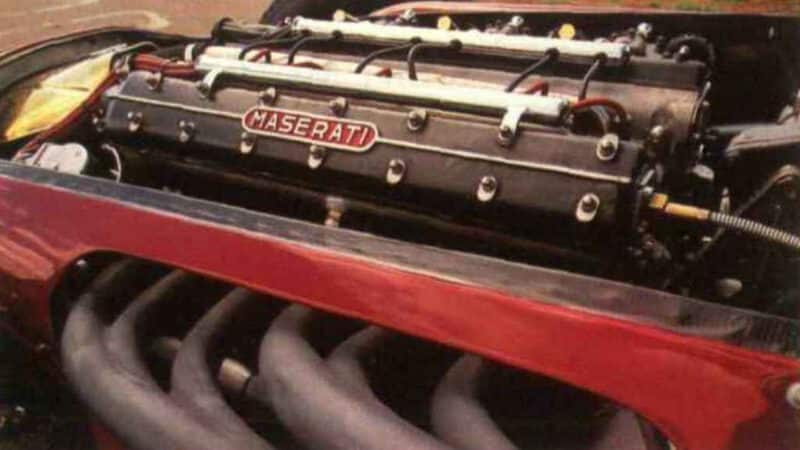
Roar of 2.5-litre six has the edge over Squalo. It is up in power stakes too
Andrew Yeadon
Staring down its exhaust pipes from the cockpit of the 250F, the Super Squalo actually seemed to have slightly more grip, and certainly appeared to be as comfortable as the 250F at the same speeds. In a longer, faster corner than Club, the Maserati would arguably have an advantage, mainly because of its longer wheelbase and better balance, but it certainly shook me how competitive the car from Maranello showed itself to be. In slow corners, in fact I would suggest that the Squalo is better at transmitting the power to the road, even allowing for the fact that it had slightly less to transmit.
With hindsight, it is easy to blame outside events for the short life-span of Aurelio Lampredi’s 555 Super Squalo. Mercedes W196-beater it most definitely wasn’t. Neither was it a Grand Prix failure. The low riding, wide bodied ‘Shark’ was arguably just races away from being developed into a consistent front-running racer when Lancia’s altruistic gesture halted any further development.
So next time you glance through the history books and read about the ignominious period that Ferrari went through in the mid-1950s, don’t blame it all on the Super Squalo. It really wasn’t that bad…
